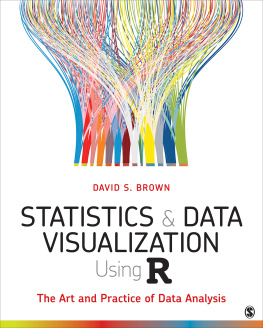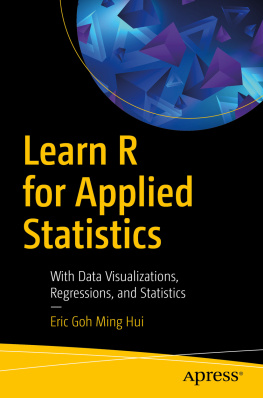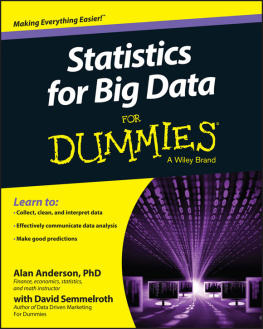

Statistics For Big Data For Dummies
Published by: John Wiley & Sons, Inc., 111 River Street, Hoboken, NJ 07030-5774, www.wiley.com
Copyright 2015 by John Wiley & Sons, Inc., Hoboken, New Jersey
Published simultaneously in Canada
No part of this publication may be reproduced, stored in a retrieval system or transmitted in any form or by any means, electronic, mechanical, photocopying, recording, scanning or otherwise, except as permitted under Sections 107 or 108 of the 1976 United States Copyright Act, without the prior written permission of the Publisher. Requests to the Publisher for permission should be addressed to the Permissions Department, John Wiley & Sons, Inc., 111 River Street, Hoboken, NJ 07030, (201) 748-6011, fax (201) 748-6008, or online at http://www.wiley.com/go/permissions .
Trademarks: Wiley, For Dummies, the Dummies Man logo, Dummies.com, Making Everything Easier, and related trade dress are trademarks or registered trademarks of John Wiley & Sons, Inc., and may not be used without written permission. All other trademarks are the property of their respective owners. John Wiley & Sons, Inc., is not associated with any product or vendor mentioned in this book.
LIMIT OF LIABILITY/DISCLAIMER OF WARRANTY: WHILE THE PUBLISHER AND AUTHOR HAVE USED THEIR BEST EFFORTS IN PREPARING THIS BOOK, THEY MAKE NO REPRESENTATIONS OR WARRANTIES WITH RESPECT TO THE ACCURACY OR COMPLETENESS OF THE CONTENTS OF THIS BOOK AND SPECIFICALLY DISCLAIM ANY IMPLIED WARRANTIES OF MERCHANTABILITY OR FITNESS FOR A PARTICULAR PURPOSE. NO WARRANTY MAY BE CREATED OR EXTENDED BY SALES REPRESENTATIVES OR WRITTEN SALES MATERIALS. THE ADVICE AND STRATEGIES CONTAINED HEREIN MAY NOT BE SUITABLE FOR YOUR SITUATION. YOU SHOULD CONSULT WITH A PROFESSIONAL WHERE APPROPRIATE. NEITHER THE PUBLISHER NOR THE AUTHOR SHALL BE LIABLE FOR DAMAGES ARISING HEREFROM.
For general information on our other products and services, please contact our Customer Care Department within the U.S. at 877-762-2974, outside the U.S. at 317-572-3993, or fax 317-572-4002. For technical support, please visit www.wiley.com/techsupport .
Wiley publishes in a variety of print and electronic formats and by print-on-demand. Some material included with standard print versions of this book may not be included in e-books or in print-on-demand. If this book refers to media such as a CD or DVD that is not included in the version you purchased, you may download this material at http://booksupport.wiley.com . For more information about Wiley products, visit www.wiley.com .
Library of Congress Control Number: 2015943222
ISBN 978-1-118-94001-3 (pbk); ISBN 978-1-118-94002-0 (ePub); ISBN 978-1-118-94003-7 (ePDF)
Statistics For Big Data For Dummies
Visit http://www.dummies.com/cheatsheet/statisticsforbigdata to view this book's cheat sheet.
- Table of Contents
Guide
Pages
Introduction
Welcome to Statistics For Big Data For Dummies! Every day, what has come to be known as big data is making its influence felt in our lives. Some of the most useful innovations of the past 20 years have been made possible by the advent of massive data-gathering capabilities combined with rapidly improving computer technology.
For example, of course, we have become accustomed to finding almost any information we need through the Internet. You can locate nearly anything under the sun immediately by using a search engine such as Google or DuckDuckGo. Finding information this way has become so commonplace that Google has slowly become a verb, as in I dont know where to find that restaurant Ill just Google it. Just think how much more efficient our lives have become as a result of search engines. But how does Google work? Google couldnt exist without the ability to process massive quantities of information at an extremely rapid speed, and its software has to be extremely efficient.
Another area that has changed our lives forever is e-commerce, of which the classic example is Amazon.com. People can buy virtually every product they use in their daily lives online (and have it delivered promptly, too). Often online prices are lower than in traditional brick-and-mortar stores, and the range of choices is wider. Online shopping also lets people find the best available items at the lowest possible prices.
Another huge advantage to online shopping is the ability of the sellers to provide reviews of products and recommendations for future purchases. Reviews from other shoppers can give extremely important information that isnt available from a simple product description provided by manufacturers. And recommendations for future purchases are a great way for consumers to find new products that they might not otherwise have known about. Recommendations are enabled by one application of big data the use of highly sophisticated programs that analyze shopping data and identify items that tend to be purchased by the same consumers.
Although online shopping is now second nature for many consumers, the reality is that e-commerce has only come into its own in the last 1520 years, largely thanks to the rise of big data. A website such as Amazon.com must process quantities of information that would have been unthinkably gigantic just a few years ago, and that processing must be done quickly and efficiently. Thanks to rapidly improving technology, many traditional retailers now also offer the option of making purchases online; failure to do so would put a retailer at a huge competitive disadvantage.
In addition to search engines and e-commerce, big data is making a major impact in a surprising number of other areas that affect our daily lives:
- Social media
- Online auction sites
- Insurance
- Healthcare
- Energy
- Political polling
- Weather forecasting
- Education
- Travel
- Finance
About This Book
This book is intended as an overview of the field of big data, with a focus on the statistical methods used. It also provides a look at several key applications of big data. Big data is a broad topic; it includes quantitative subjects such as math, statistics, computer science, and data science. Big data also covers many applications, such as weather forecasting, financial modeling, political polling methods, and so forth.
Our intentions for this book specifically include the following:
- Provide an overview of the field of big data.
- Introduce many useful applications of big data.
- Show how data may be organized and checked for bad or missing information.
- Show how to handle outliers in a dataset.
- Explain how to identify assumptions that are made when analyzing data.
- Provide a detailed explanation of how data may be analyzed with graphical techniques.
- Cover several key univariate (involving only one variable) statistical techniques for analyzing data.
- Explain widely used multivariate (involving more than one variable) statistical techniques.
- Provide an overview of modeling techniques such as regression analysis.
- Explain the techniques that are commonly used to analyze time series data.
- Cover techniques used to forecast the future values of a dataset.
- Provide a brief overview of software packages and how they can be used to analyze statistical data.
Next page









![Thomas Mailund [Thomas Mailund] - Beginning Data Science in R: Data Analysis, Visualization, and Modelling for the Data Scientist](/uploads/posts/book/119629/thumbs/thomas-mailund-thomas-mailund-beginning-data.jpg)


